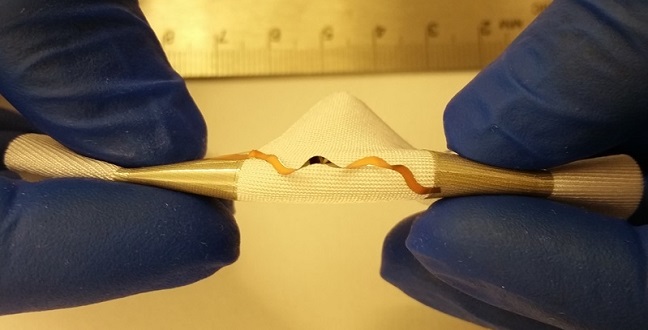Electrical Engineering
An antenna that goes the distance
A low-cost, copper-based flexible and stretchable antenna improves far-field data communication in wearable electronics.


KAUST researchers have developed the first-ever flexible, stretchable antenna for wearable electronics that can operate at a single continuous frequency over distances of up to 394 meters.
Reproduced with permission from Ref 1.© 2015 WILEY-VCH Verlag GmbH & Co. KGaA, Weinheim
Many wearable and mobile gadgets rely on Bluetooth technology to transmit data, a method which is only effective over short distances and is unreliable for long-range communications. Researchers at KAUST have now developed a wearable, stretchable antenna capable of maintaining communications at a constant frequency over distances of up to 394 meters1.
Potential applications for wearable electronics include real-time medical devices that monitor a person’s vital signs and technology for training athletes. A sensor integrated into an athlete’s shirt, for example, could potentially share real-time data with a receiver across the stadium if the data could be transmitted efficiently at a constant frequency.
“Wearable electronics are prone to a lot of physical deformation, including stretching and twisting,” explained Muhammad Mustafa Hussain of the Integrated Nanotechnology Lab at KAUST, who led the project team of scientists from KAUST and the University of Illinois (U.S.) “Previous antenna designs used stretchable polymeric material and liquid metal, but because the physical dimensions of the antennas themselves were changing, they could not operate at a single frequency, and data transmission was badly disrupted.”
Regardless of body movement, the physical dimensions of a wearable antenna must not change if it is to function at a constant frequency. Hussain and his team came up with a unique antenna design: an ultrathin copper strip was twisted into a helical spring structure. The copper was backed with polyimide, a polymer that both insulates and supports the metal.
“By making the copper thin, we ensured it was flexible, and the fractal design makes it stretchable,” said Hussain. “The spring-shaped antenna can twist without breaking or changing its dimensions. In our design, each end of the spring is attached to a polymer-based support pad, suspending the antenna in the air. This minimizes contact with the human body, which is a loss medium that can limit communication ability.”
The antenna proved robust, maintaining its functional ability under intensive strain tests. In field trials with the antenna attached to an athlete’s sleeve, the device functioned well at a single frequency of 2.45GHz (the most common WiFi frequency) and communicated data to a receiver at distances of up to 394 meters.
“Fundamentally, we have solved an age-old problem related to metal work – that metal is inherently unstretchable,” noted Hussain. “With this breakthrough using polymer-backed thin metal films, the future of wearable electronics looks very promising.”
References
- Hussain, A.M., Ghaffar, F.A., Park, S.I., Rogers, J.A., Shamim, A. & Hussain, M.M. Metal / polymer based stretchable antenna for constant frequency far-field communication in wearable electronics. Advanced Functional Materials doi: 10.1002/adfm.201503277 (2015). | article
You might also like

Bioengineering
Smart patch detects allergies before symptoms strike

Computer Science
Green quantum computing takes to the skies

Electrical Engineering
Micro-LEDs boost random number generation

Bioengineering
Sensing stress to keep plants safe

Computer Science
Sweat-sniffing sensor could make workouts smarter

Electrical Engineering
New tech detects dehydration by touching a screen

Electrical Engineering
A new interface for efficient electronics

Electrical Engineering



